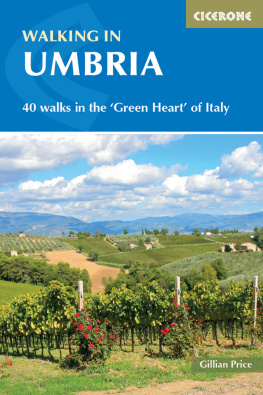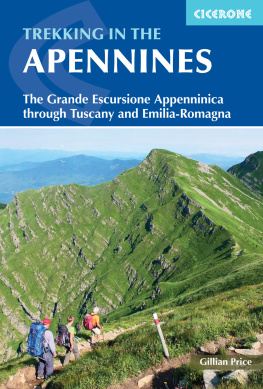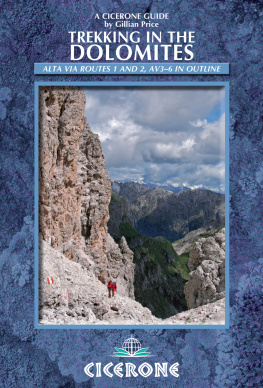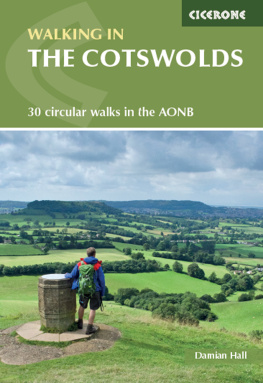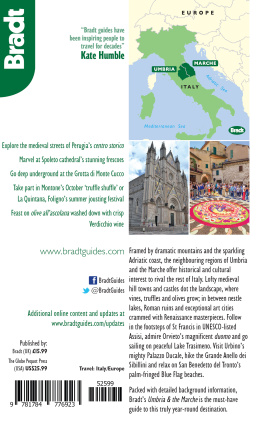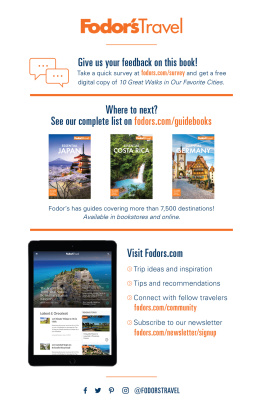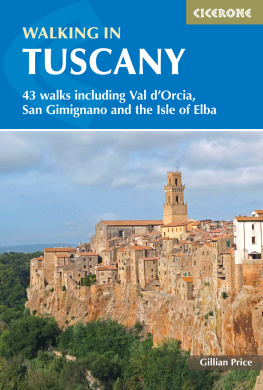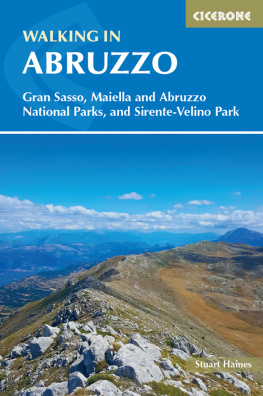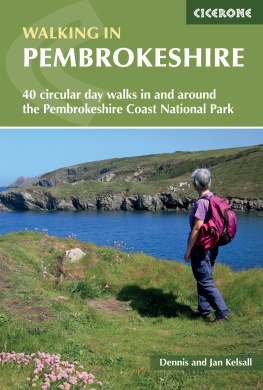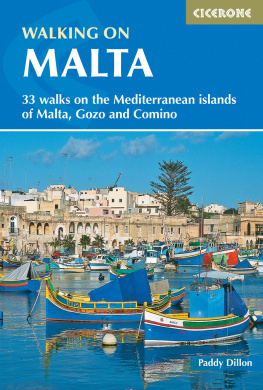About the Author
Gillian Price was born in England but moved to Australia when young. After taking a degree in anthropology and working in adult education, she set off to travel through Asia and trek the Himalayas. The culmination of her journey was Venice where, her enthusiasm fired for mountains, the next logical step was towards the Dolomites, only hours away. Starting there, Gillian is steadily exploring the mountain ranges and flatter bits of Italy and bringing them to life for visitors in a series of outstanding guides for Cicerone.
When not out walking with Nicola, her Venetian cartographer husband, Gillian works as a freelance travel writer (www.gillianprice.eu). An adamant promoter of public transport to minimise environmental impact, she is an active member of the Italian Alpine Club CAI and Mountain Wilderness.
Other Cicerone guides by the author
Across the Eastern Alps the E5
Alpine Flowers
Gran Paradiso: Alta Via 2 Trek and Day Walks
Italys Sibillini National Park
Italys Stelvio National Park
Shorter Walks in the Dolomites
Through the Italian Alps the GTA
Tour of the Bernina
Trekking in the Apennines the GEA
Trekking in the Dolomites
Walking and Trekking on Corfu
Walking on the Amalfi Coast
Walking in the Central Italian Alps
Walking on Corsica
Walking in the Dolomites
Walks and Treks in the Maritime Alps
Walking in Sicily
Walking in Tuscany
Walking Lake Como and Maggiore
Walking Lake Garda and Iseo
WALKING IN UMBRIA
by Gillian Price
JUNIPER HOUSE, MURLEY MOSS,
OXENHOLME ROAD, KENDAL, CUMBRIA LA9 7RL
www.cicerone.co.uk
Gillian Price
Second edition 2019
ISBN 9781783627721
First edition 2014
ISBN 978 1 85284 711 1
Printed by KHL Printing, Singapore.
A catalogue record for this book is available from the British Library.
All photographs are by the author unless otherwise stated.
Acknowledgments
For their help and maps, I would like to thank Tourist Offices throughout Umbria: Assisi, Cascia, Castiglione del Lago, Citt di Castello, Foligno, Gubbio, Orvieto, Perugia, Spoleto, along with the Comune di Todi (Marco Spaccatini), Paolo Capocci for ex SpoletoNorcia railway and Umbria branches of the Italian Alpine Club CAI especially Luigino of Gubbio.
On the trail I enjoyed the enthusiastic company of Marty, Lucy and Clive who doubled as chauffeurs. Nicola kept the jokes coming, and did more of his marvellous maps. Grazie mille! This is a guidebook I didnt want to finish, as researching it was my excuse to return to glorious Umbria to seek out yet another unknown valley.
Updates to this Guide
While every effort is made by our authors to ensure the accuracy of guidebooks as they go to print, changes can occur during the lifetime of an edition. Any updates that we know of for this guide will be on the Cicerone website (www.cicerone.co.uk/966/updates), so please check before planning your trip. We also advise that you check information about such things as transport, accommodation and shops locally. Even rights of way can be altered over time. We are always grateful for information about any discrepancies between a guidebook and the facts on the ground, sent by email to updates@cicerone.co.uk or by post to Cicerone, Juniper House, Murley Moss, Oxenholme Road, Kendal LA9 7RL.
Register your book: To sign up to receive free updates, special offers and GPX files where available, register your book at www.cicerone.co.uk.
Front cover: One of the well-established vineyards near Montefalco
CONTENTS
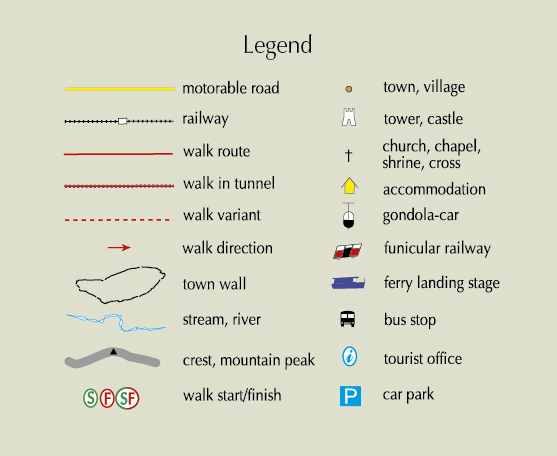
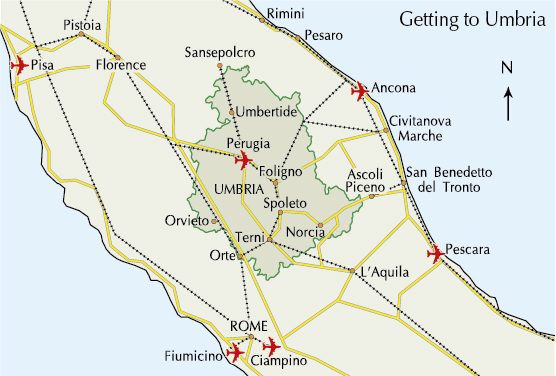
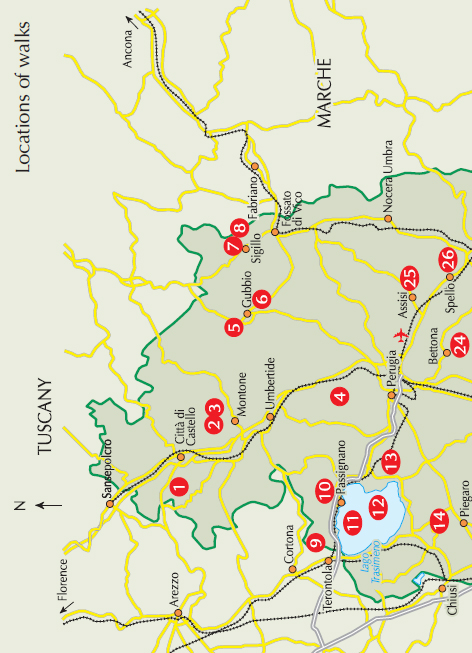


Eroding rock layers en route to Monte Gengarella (Walk 3)
INTRODUCTION

Vallo di Nera sits above wooded Valnerina (Walk 31)
Landlocked Umbria, with its array of fabulous landscapes, inspirational for so many artists and writers over the years, is rightly celebrated as the green heart of Italy. Rolling hills swathed in dense woods, hilltop after marvellous hilltop occupied by charming walled villages which time seems to have left untouched. This region has much to offer outdoor enthusiasts, with superb walking guaranteed year-round on hundreds of kilometres of marked paths. These routes can be enjoyed in peace and quiet, for week upon week of memorable holidaying. They lead through beautifully cared for olive groves, along romantic river valleys, and explore regional and national parks alive with animal and bird life and masses of brilliant wildflowers. There is something for everyone relaxing strolls for novice walkers through medieval and Renaissance villages and towns, flat routes around lakes and islands, as well as mildly strenuous paths to Apennine mountaintops and breathtaking viewpoints.
More good news? Life proceeds at a gentle pace in Umbria, which has little of the crowds and higher prices of its neighbour Tuscany. This is the first English-language walking guide to provide a comprehensive coverage of the walking possibilities, with a selection of 40 circular and one-way itineraries. The walks are clustered around the Unesco World Heritage towns of Assisi, Spoleto, Gubbio, Perugia, Norcia and Orvieto, each one a treasure trove of exquisite art works from the medieval and Renaissance times, as well as an excellent holiday base well served by public transport.
Umbria inspires great passion and affection, and visitors who take time out to explore this enchanting countryside on foot are sure to be captivated by its magic and want to come back time and time again. Be warned!
A potted history
Visitors to Umbria will encounter scores of reminders of the regions long and varied history in towns and across the countryside. The ancient tribe of the Umbri were the first recorded literate inhabitants of the region, probably around the 12th century BC . The more sophisticated Etruscans came next, leaving a fascinating heritage of necropolises or cities of the dead, and sophisticated craftwork (excellent examples of which can be admired in Orvieto).
The Romans fought their way onto the scene in 295 BC and proceeded to play a decisive part in shaping the region. Road builders par excellence, they opened up access to and around Umbria by building the Via Flaminia, the Via Amerina-Tiberina and the Via Orvietana. Original paving stones are still visible at staging-post towns. Aqueducts (at Spello) and monumental theatres (at Gubbio) are also easily recognised as Roman.
As elsewhere, the end of peace and prosperity was marked by the decline of Roman domination and raids by barbarians such as Huns and Goths passing through. The territory became fragmented, plague and famine rife, and local feudal systems took over, until the 6th-century invasion of the enlightened Lombards. Medieval times were characterised by the establishment of numerous so-called comuni or independent city states such as Spoleto and Assisi. Landmark town buildings date back to this period as do the heavy fortifications. Local skirmishes were the order of the day.

